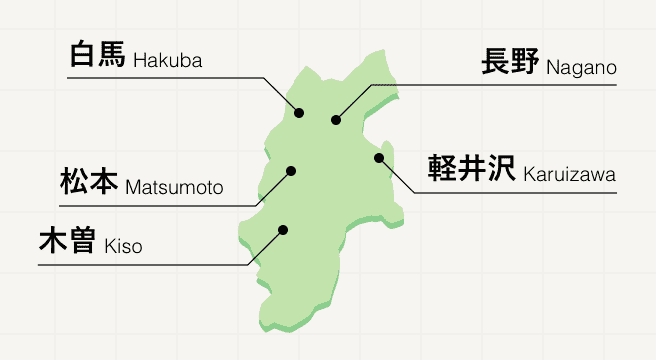Historical Road Spots in Eastern Shinshu Area
Area
-
-
Nagano
-
-
Nagano

Category


-
- Mochizuki-shuku
- Travel / Tourism
- Nagano Saku-shi Mochizuki
- "This area was once the 25th station counting from Edo of the 69 stations of the old Nakasendo Road. ""Mochizuki"" is an old term which refers to the 15th day of the lunar month, a name it gained because the area made many gifts of horses on the harvest moon during the Nara and Heian periods. During the Edo period, the area was a post station town bustling with travelers and possessed an official honjin government inn, waki-honjin sub-inn, taverns, and wholesalers, and even today traces of this time can be found at every turn. The Mochizuki History Folklore Archives was opened on the site of the former honjin and here visitors can learn about the history and culture of the Mochizuki area. The Sanayama House, an inn and wholesaler's at the time, has been designated a National Important Cultural Property."
-
- Nakasendo Yawata-juku
- Travel / Tourism
- Nagano Saku-shi Kuwayama
- The Yawata-juku is the 24th inn counting from Edo (now Tokyo) and was built in the early Edo period (1603-1868) as a rice distribution center in the surrounding granary area, and is also known as the place where the Imperial Princess Wamiya stayed when she married. The Hachiman Shrine near the main camp is a historic shrine from which the name Yawata-juku was derived, and within its precincts is the Kora Shrine, designated as a national important cultural property, which is said to be a shrine related to the people who came to Japan from overseas.
-
- Motaiai no Shuku
- Travel / Tourism
- Nagano Saku-shi Motai
- The street used to connect Mochizuki and Ashida Inns on the Nakasendo Highway, and was used as a rest stop for large groups of passengers who could not make it to Mochizuki or Ashida Inns. The area is also home to a monument to the poet Makisui Wakayama, who stayed here during the Meiji period (1868-1912).
-
- Oiwake-shuku
- Travel / Tourism
- Nagano Kitasaku-gun Karuizawamachi Oiwake
- The Oiwake-juku Museum and the Hori Tatsuo Literature Memorial Museum are also located in this area.
-
- Nakasendo Otai-juku
- Travel / Tourism
- Nagano Kitasaku-gun Miyotamachi
- The Odai-juku Festival, held annually on August 16, features a procession of people carrying palanquins with dolls given to them by the Princess Wamiya, who stayed at the inn when she married into the Shogun's family at the end of the Edo period. The dolls are carried in a palanquin and paraded in a procession.
-
- Hokkoku Kaido Yanagimachi
- Travel / Tourism
- Nagano Pref. Uedashi Chuou 4
- A street located in the center of Ueda City. Situated along the Hokkoku Kaido, an ancient highway, in the Edo period, the street was lined with many inns, merchants, and dry goods stores; in the Meiji period, the sericulture industry also flourished here. Today, the street still retains much of this Edo period atmosphere, but is now occupied by many restaurants, bars, cafes, and shops offering Shinshu soba noodles, local liquors, and tea. Visitors can feel the history of the area as they explore the street.
-
- Nakasendo
- Travel / Tourism
- Nagano Chiisagata-gun Nagawa Machi Nagakubo 2028-2
Nagano Areas

Nagano prefecture is an exciting mix of mountains, hot spring monkeys, and preserved Edo history. At the heart of the Japanese Alps, Nagano is one of the country’s most popular destinations, whether in winter for its snow sports and the much-loved Jigokudani Monkey Park or in the warmer months for discovering the undulating hills on foot. For fantastic Edo architecture, head to the Kiso Valley for a 60-kilometer stretch of quaint wooden buildings that marked the Nakasendo route 200 years ago.
Best of Nagano
Search by Region
-
- Hokkaido / Tohoku
- Hokkaido
- Aomori
- Iwate
- Miyagi
- Akita
- Yamagata
- Fukushima
-
- Kanto
- Ibaraki
- Tochigi
- Gunma
- Saitama
- Chiba
- Tokyo
- Kanagawa
-
- Koshinetsu / Hokuriku
- Niigata
- Toyama
- Ishikawa
- Fukui
- Yamanashi
- Nagano
-
- Tokai
- Gifu
- Shizuoka
- Aichi
- Mie
-
- Kinki
- Shiga
- Kyoto
- Osaka
- Hyogo
- Nara
- Wakayama
-
- Chugoku
- Tottori
- Shimane
- Okayama
- Hiroshima
- Yamaguchi
-
- Shikoku
- Tokushima
- Kagawa
- Ehime
- Kochi
-
- Kyushu / Okinawa
- Fukuoka
- Saga
- Nagasaki
- Kumamoto
- Oita
- Miyazaki
- Kagoshima
- Okinawa

















